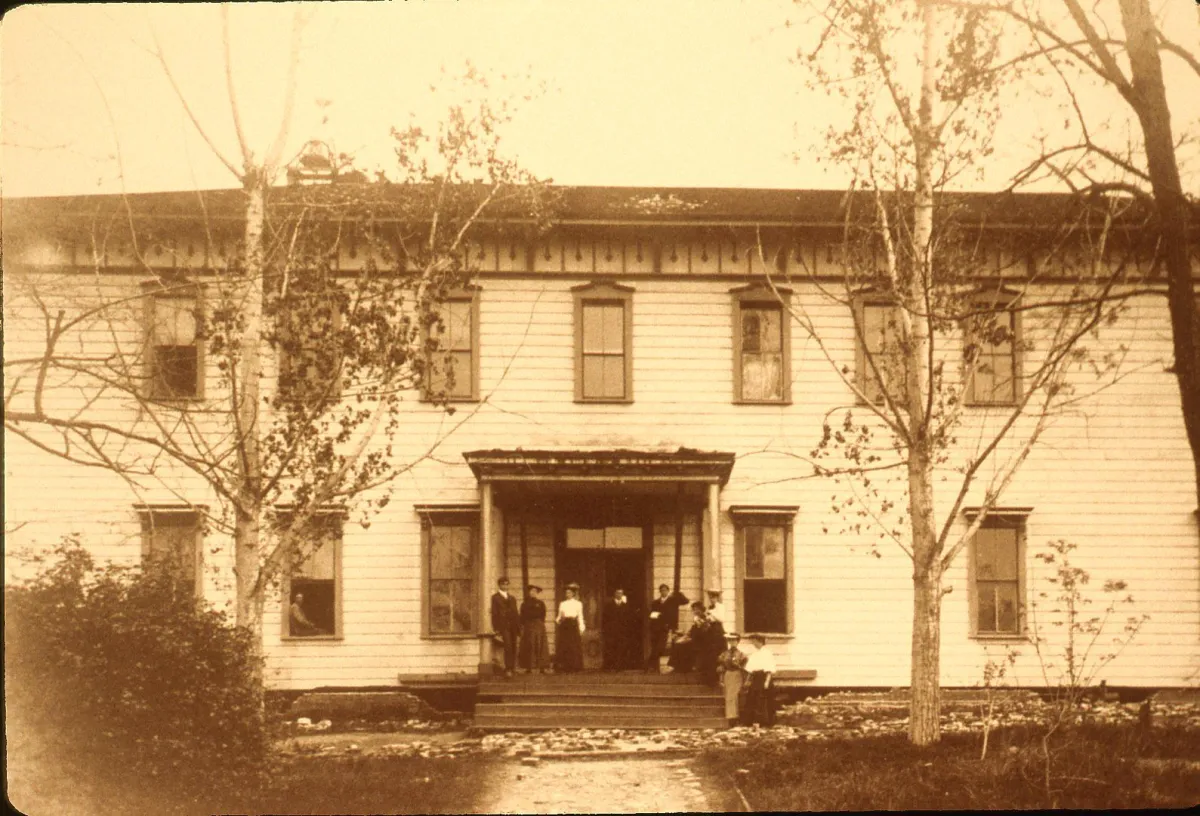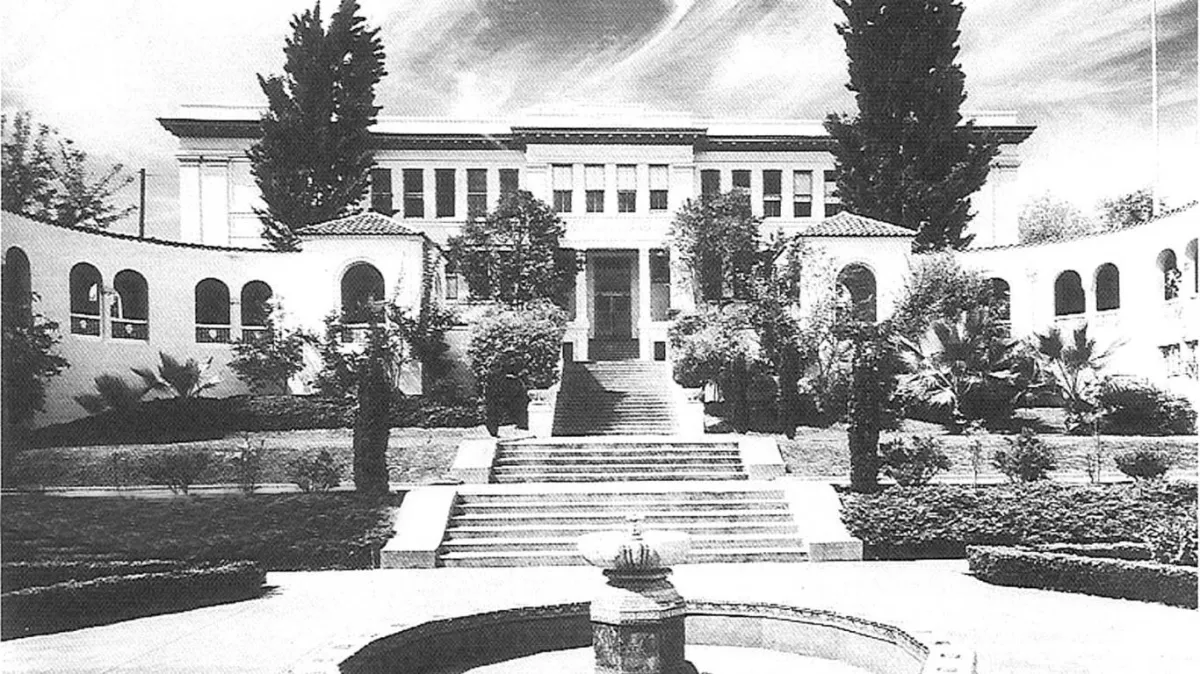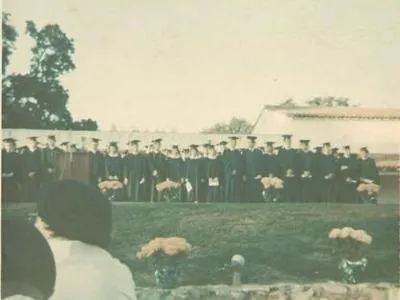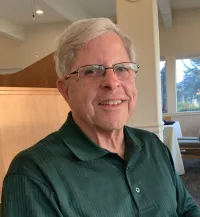Placer High
History
Exploring the Rich Heritage: Placer High's Journey
1930's Upper Campus

1897 First Upper Campus Building
1887-1906
The Beginning
Placer High School’s origins can be traced back to 1882 when three young men from the East Coast arrived in Auburn with a dream of creating a college for Northern California. The trio met with influential members of the community in the Placer County Courthouse and began a campaign to solicit donations to the building fund of the Sierra Normal College and Business Institute. When the contributions reached $6,000, the three young teachers, M.L. Fries, A.W. Sutphen, and M.W. Ward contributed $1500 each and began to search for a building site.
General Jo Hamilton, a former Attorney General for the State of California during the 1870s had retired to Auburn by this time and built a home on an estate at the corner of what is now High Street and College Way. He donated a five-acre parcel of his land to the newly-formed school. By 1883 Sierra Normal College was advertised in the Placer Argus newspaper as “the only independent normal college on the Pacific Coast.” Normal in this instance meant preliminary, professional education of teachers. It also advertised that “students can enter at any time, select what studies they choose, and advance as rapidly as their attainments will permit.”
The first year 1897 marks the beginning of Placer High School. In that year a Professor DeBell and the City of Auburn leased the Sierra Normal College building and property and ran the school under the name of Auburn High School.
In September of that year the school began operations with 17 students present, all of whom paid tuition. Auburn High School graduated its first class in June of 1900 at the opera house, the result of a three-year study. There were 10 students, six boys and four girls—five of them attended the University of California. At the time half of the students came from towns other than Auburn. The class of ’00 consisted of Mabel Coddington, Cyrus Dickson, Marie Fulton, Myrtle Meacham, Homer Norton, Edward Peterson, Fred Peterson, Emily Roberson, eddy R. Safford, and Ernest Wood.
In the first four years student population grew and more pupils were coming from outside of Auburn. This growth required more teachers and money and in 1901 the electors of Placer County voted for a high school and the name was changes to Placer County High School. Two years later in 1903 the county purchased the building and grounds from Dr. Ward, the president and sole owner of the former Sierra Normal College.
1930-1936
The Engle Era
Dr. John F. Engle became principal of Placer High School in 1906 and began a long and illustrious 30-year career in which the school expanded from five teachers in one rickety wooden building to an 800-student faculty boasting five buildings and the creation of a junior college. At the same time the high school developed a reputation throughout the state as one of the finest secondary institutions of the Placer High School District which extended from Loomis to Lake Tahoe.
Several landmark buildings were added during Engle’s stay as principal. During the 1906-07 school years the original Sierra College wooden building was torn down and replaced

1930's Upper Campus Building
by a $40,000 building. The new building was a substantial brick structure consisting of 22 rooms on four levels, including a basement, and a large tin dome. Heating was by an automatic system which regulated both temperature and ventilation in every room. Within a few years statuary, pictures, and potted plants were added to beatify the interior of the school. The library was considered one of the finest in Northern California and the collection of American history in the History department was the best in Northern California.
In 1909 shower baths and lockers for the Athletes were installed downstairs in the new building. In the next few years tennis courts were finished on the site of the old wooden building and a football field and track were installed. By 1918 the school showcased a large wooden gymnasium with sideline seating and a stage. The year 1926, however marked the beginning of a new era for Placer when the music/auditorium and science wings were added and the brick building was plastered over to match the architectural style of the two new wings. The auto shop and bus shed building along Agard Street were also constructed at this time. Ten years later, building began on Placer Junior College buildings, gym and athletic field during the final year of Engle’s administration, 1936.
Athletics began to have an impact on the school during Engle’s tenure as well. In addition of a young coach from the University of California, Earl Crabbe, enabled the girls’ and boys’ basketball teams to create a dynasties of legendary significance. Between 1916 and 1920 his girls’ basketball team went 41-1 winning 37 games in succession at one point, compiling four straight undefeated seasons. Beginning in 1923 his boys’ basket ball teams won 16 out of 17 league championships, including 12 in a row. Crabbe also coached his men to eight Central California titles in 13 appearances.
Engle was at the helm as a student endured the tragedy of World War I when a junior Red Cross Club was organized on campus with girls learning to make surgical dressings and the entire school donating over $500 to a war drive. The Engle years also saw the formation of the first high school cadet corps in the State of California under the direction of Captain Fred S. Roumage, a National Guard officer and later captain in France in World War I.
The year 1914 marked the birth of the Placer High School district, thus again changing the names of the school to Placer High School. That same year college level classes were revived after having disappeared several years earlier. However, due to the enrollment drain caused by World War I, the junior college was abandoned by 1920.
Certain ceremonies were now becoming traditional such as the Freshman Reception, the Christmas Jinx, the Junior Prom, the Senior Ball, Senior Picnic, and the Graduation and Alumni Dance. Participation in clubs and organization also grew, beginning with the Agricultural Science Organization which became the Future Farmers of America, the oldest club in existence. During the period of time the Placer Band came into prominence under the guidance of Otto Fox, entertaining the school and the community at various concerts and public performances.
Academics also took on prominence during the Engle principalship. A four year curriculum became the norm with students tracked into Classical, Scientific, or Commercial fields of study. All paths were stiffly challenging with semester finals a dreaded period of time for the students. Miscreant students were dealt with severely and Detention became an unwelcome punishment. Still, Engle and his vice-Principal E.F. Waldo were highly respected by the students and could be seen attending various cultural, social and Athletic events at the school.

Class of 1966
1960-1997
The Independence
By 1960 Placer High School grew in terms of physical space but reduced in population. The junior college had vacated its campus, moving to Rocklin as Sierra College, and two new high schools, Del Oro and Colfax, became part of the high school district. Placer High which began as a one-building facility in 1897 had an upper and lower campus comprised of eleven white stucco and red tiled buildings. More buildings would appear in the final three decades.
By the end of the sixties the school boasted an on-site stadium for football and track, a new library, and new history and English wings which replaced the 1906 brick building. The 1926
science and auditorium wings were renovated by the seventies and a new practice gymnasium was built behind the venerable Earl Crabbe Gym in 1982. Students lived through highly interesting times, dancing the twist, the jerk, the swim, the watusi, and the monkey of the sixties, experiencing freedom from dress codes, and the protest of the seventies, along with some new traditions and legends. Homecoming became a colossal event beginning in 1967 when a five day celebration was declared, including a night rally, a bonfire, a Powder-Puff football game, and a dance, all a prelude to the big game against arch-rival Roseville. Senior pranks gained popularity, with one class, the Class of 1974 mounting 74 tires around the flag pole in the quad.
New faculty faces moved in to replace legends of old and create legends of their own. Glenda Gonzales created a strong music program producing the first musical, Finian’s Rainbow, in 1965 and following it nearly every year with another Broadway hit. Her 1976 choir was honored as a Bi-centennial choir, and toured the nation’s capital. The Art Department under the guidance of Mario Ferrante, exhibited student work in an annual art shows for the school and the community. The student newspaper was revived under a new name, The Hillmen Messenger, several years after the demise of the Placer Union. The Vocational Industrial Club of America came into existence in the eighties, garnering several regional and state gold medals in competitions.
Placer excelled in sports during this period of time as Tom Barry took over the helm adding to the heritage of the Crabbe and LeFebvre coached teams, and creating his own glory. His teams won eight league titles in 12 years, including six in a row, at one point in the seventies, and he retired in 1979 averaging twenty wins per season. Bill Flake began a wrestling program at Placer in 1965. Before retiring, he coached his grapplers to seventeen league championships and guided two wrestlers, Steve Stratton and Gary Anderson, to state titles.
Tom Johnson and Bill Miller teamed up as co-coaches to guide the Hillmen football program to its most successful era. From 1973 to 1982 they compiled a 93-18-1 record and five Sac-Joaquin Section titles. Three times they achieved undefeated seasons and twice they were ranked Number 1 in the state. Miller went on to coach the girls’ tennis and build a state powerhouse team that won 12 straight league championships and nine Sac-Joaquin Section titles. Radley McCord coached the boys’ tennis team to similar dominance. In the nineties, the Senior Project became a requirement for the students and the program paid off as student projects led to the Hall of Fame, an all-weather track, a Centennial Arch and brick walkway, and an art gallery among other projects. New educational concepts went into effect as well. The concept of Quality Schools became a reality with students given more responsibility to make decisions concerning their lives and education in a non-coercive environment. Finally, as Placer High School approached the end of its first century, the school applied for and received Charter School status, enabling the school to be run on independent state of education codes.
OUR FOCUS
FOUNDATION FOUCS: OUR IMPACT AREAS

ACADEMICS
We empower students, faculty, and staff for enhanced learning through grants, tech initiatives, and scholarships, propelling them into a successful future beyond high school.

ATHLETICS
Hillmen Foundation fuels athletic achievements through grants, enhancing safety, facilities, and community fitness.

ACTIVITIES
We foster holistic education by supporting diverse activities through grants, enriching students' experiences beyond the classroom.

ALUMNI
Placer High's rich history shines through alumni activities, fostering a strong network connecting generations and the community.

SPECIAL PROJECTS & INITIATIVES
Placer High's prime Auburn location fuels community growth, enhancing facilities and programs through strategic grants.
GYM CLASSES
WHAT YOU GET FROM ENDURANCE MEMBERSHIP
A small river named Duden flows by their place and supplies it with the necessary regelialia.
A small river named Duden flows by their place and supplies it with the necessary regelialia.
A small river named Duden flows by their place and supplies it with the necessary regelialia.
A small river named Duden flows by their place and supplies it with the necessary regelialia.
A small river named Duden flows by their place and supplies it with the necessary regelialia.
NEWS AND EVENTS
Fresh Updates Await Your DISCOVERY
Explore Placer High School's vibrant academics, activities, and athletics, keeping you connected to the staff, students, and valued alumni, uniting a passionate community supporting the school.

My Unique Vantage Point: The Evolution of the Hillmen Foundation
One of the most rewarding things about being a teacher is fostering a student’s growth over the years. Seeing goofy, awkward freshman become confident seniors is a true pleasure. Watching them achieve their potential and become a contributing member to their community is a bonus.
I feel the same about the Hillmen Foundation. It’s been my pleasure to watch the organization grow from a small group of interested individuals to a powerful non-profit that supports the students of Placer High School.
The Foundation was born out of necessity. In 1978, California voters passed Proposition 13 which drastically cut and capped property taxes and hobbled the state’s ability to raise money for schools. Overnight, the tax revenue available to pay for public schooling was slashed by one-third. Throughout the next decade, Placer High School suffered funding cuts along with the rest of the state.
To address the issue, in 1989, former Placer High School Principal Jug Covich and Teacher/Coach Tom Johnson teamed up with a small committee of Auburn citizens to form the Hillmen Foundation as a 501(c)3 non-profit. The mission of the foundation was to support Placer High programs in academics, activities, and athletics; to stimulate gifts of service, endowments and bequests; and to maintain an association of persons interested in Placer High School.
At first, the committee was comprised of five officers and three committee members of which I was one. In the early years, we held infrequent meetings at Jug Covich’s house, feasting on pies and cookies made by Barbara Covich and doling out grants to teachers at Placer who had applied for support. Much of the meetings involved Covich and Johnson comparing Cal and USC football stories.
At first the Foundation used small membership revenues to support its mission. Then in 1991, Auburn citizen Alonzo Hazen, a PG&E employee, came to the rescue. Upon his death, he left the bulk of his estate to Placer High School for a science scholarship to be awarded to a graduating boy and girl. The Hillmen Foundation became the executor of the estate, which included approximately $23,000 in cash, PG&E stock that generated nearly $500 a quarter at the time, and a home which was sold for $100,000.
During the 1990s when Johnson was the principal of Placer High, he held weekly Bingo nights at the Auburn Gold Country Fairgrounds to raise money for the Foundation. He called the numbers and each night a different school club or academic department worked the event, receiving a portion of the proceeds.
Bingo nights were difficult for the principal and teachers, requiring evening work after a full day at school. And, because smoking was still allowed in public buildings at that time, a majority of the players indulged in their nicotine habit all night long. Exhausted school workers went home at night, their clothes and hair reeking of cigarette smoke, but their programs enhanced financially.
In 1997, the school celebrated its centennial. A committee of Placer alumni and community persons worked for three years in advance of the celebration. During the three-day event, I had the opportunity to view how special Placer High is in the hearts of its graduates. Old Town Auburn was closed down on Friday night, and graduates, friends, and family packed the streets sharing food and drink and memories.
Individual classes assembled at the Fairgrounds on Saturday for specific year reunions. Sunday featured a parade of cars representing almost each of the past 100 years down High Street, and concluded with a massive picnic at the Fairgrounds.
It was evident to me that Placer High is a special place with a strong emotional bond that ties the alumni and the community and its citizens to the school. The Hillmen Foundation received all proceeds from the celebration, allowing us to function for the next several years.
Under Johnson’s chairmanship, the Foundation grew to include more members and reached a total of 12. In 2014, the Foundation stepped into a fund-raising mode to hold a community dinner called Hillfest on the field at LeFebvre Stadium. More than 300 paying guests and business sponsors attended to hear various club advisors and coaches describe activities at the school. Again, the Hillmen Foundation received all proceeds from the event which allowed us to proceed with grants to PHS academics, activities, and athletics.
Various Placer grads were so thrilled with the Centennial celebration that several got together in 2014 to begin planning an encore event, the All-Class Reunion, even though the date held no insignificant historical marker. The committee met for more than a year to create the affair. At the Fairgrounds. Individual classes held reunions and festivities included music, socializing and dancing on Saturday night with a picnic on Sunday. The Hillmen Foundation again received proceeds from the event.
The Foundation experienced a complete restructuring in 2018 to include a new set of by-laws, an Executive Board, and four new committees (Finance, Fund Raising, Community-School Relationship, and Governance). New members were added and the board expanded to 26 voting members. Meetings were held quarterly. Teachers made formal applications for grants and also appeared at Foundation meetings to make presentations and answer questions.
In 2022, the school celebrated its 125-year anniversary and the foundation was the driving force in planning a school-community celebration in October. The weekend began with a football game on Friday night. On Saturday, an all-class and community street gala was held in a closed off Old Town with music, dancing, and food and refreshment booths. Individual class reunions were held Sunday at the Auburn Recreation Park.
Next year, the Hillmen Foundation will celebrate 35 years of existence with smaller, special events currently in the planning stages.
When I was asked to be a committee member the Hillmen Foundation back in 1989, I had no idea the impact the organization would have on Placer High School. As I look back on the 34 years that I’ve been a committee member, board member and for 10 years the chairman, I’ve come to realize the significance of our organization.
Some of the things we’ve done are easily recognizable — the Centennial Archway at the entrance to the school, the football stadium scoreboard, and the snack shack inside the Earl Crabbe Gym. Mostly, however, the grants we’ve provided over the years impact the students directly, enriching their education in the classroom.
I am confident that the technology we’ve supplied in the form of 3-D printers, calculators, computers, cameras, and scanners has enhanced the educational experience and future for students. I know that the field trips for at-risk students and the various band instruments we’ve provided gave students the social and cultural experiences they might not have without the Foundation. And I’m sure the program support and conferences we’ve furnished teachers has allowed them to grow in their profession and continue the legacy and rich heritage of the school that has defined Placer High for 126 years.
After 10 years at the helm, Bob recently retired from his position as Chair of the Hillmen Foundation Board of Directors. As one of our first members, he remains active as a Director with the Foundation, as well as with the Placer Athletic Hall of Fame. In addition to his years of teaching at Placer High, Bob was also the long-time announcer for Hillmen football and the LeFebvre relays.
GET INVOLVED
Grants
ACADEMICS
ICON
Lorem ipsum dolor
ENJOY ALL THE FEATURES
Lorem ipsum dolor
Lorem ipsum dolor
Lorem ipsum dolor
Lorem ipsum dolor
ATHLETICS
ICON
Lorem ipsum dolor
ENJOY ALL THE FEATURES
Lorem ipsum dolor
Lorem ipsum dolor
Lorem ipsum dolor
Lorem ipsum dolor
ACTIVITIES
ICON
Lorem ipsum dolor
ENJOY ALL THE FEATURES
Lorem ipsum dolor
Lorem ipsum dolor
Lorem ipsum dolor
Lorem ipsum dolor

ALUMNI
A small river named Duden flows by their place and supplies it with the necessary regelialia. It is a paradisematic country

SPECIAL PROJECTS & INITIATIVES
A small river named Duden flows by their place and supplies it with the necessary regelialia. It is a paradisematic country

SCHOLARSHIPS
A small river named Duden flows by their place and supplies it with the necessary regelialia. It is a paradisematic country
CELEBRATE
HILLMEN HISTORY
Below is a series of monthly historical articles leading up to the Community Celebration of Placer's 125th year
on October 1st 2022 written by Hillmen Foundation
Chair Bob Burge for The Auburn Journal. Click on the title links.
In the best of times, in the worst of times, at all times… It’s great to be a Hillman!
OUR MISSION
The purpose of the Hillmen Foundation is to support Placer High School in the areas of academics, student activities, and athletics, including the staff, students, and alumni endeavors of the school; to stimulate gifts of service, endowments, and bequests; and to maintain an association of persons interested in Placer High School.
FOCUS
Academics
Athletics
Activities
Alumni
Special Projects & Initiatives
Copyright ©2023 All rights reserved
$825,375
TOTAL IMPACT TO DATE, INCLUDING...
$594,650
GRANTS PROGRAMS, INCLUJDING...
$160,469
ACADEMICS
$70,105
ATHLETICS
$34,531
ACTIVITES
$24,736
ALUMNI
$304,809
SPECIAL PROJECTS & INITIATIVES
SCHOLARSHIP PROGRAM*
$230,725
TOTAL AWARDED
17
CURRENT SCHOLARSHIP OPPORTUNITIES
$29,750



